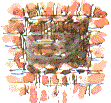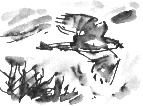Nature Diary Rocks History Gallery Links Home Page   BOXING DAY is grey and rainy. A female Sparrowhawk leaves her ledge on an old mill and flies across the river, keeping low over the field, towards the canal. She seems so large and her flight so heavy and laboured that, for a moment, I wonder whether it is a different, slightly larger species of falcon. I notice what could be the remains of jesses trailing from her legs, but I think it's just a fragment of her prey.
BOXING DAY is grey and rainy. A female Sparrowhawk leaves her ledge on an old mill and flies across the river, keeping low over the field, towards the canal. She seems so large and her flight so heavy and laboured that, for a moment, I wonder whether it is a different, slightly larger species of falcon. I notice what could be the remains of jesses trailing from her legs, but I think it's just a fragment of her prey.
The Kingfisher can nest as early as April. At one time I'd have thought the holes in the low earthy cliff on the opposite bank of the river were the exposed ends of rat burrows. But in this case I think that they are nest holes made by kingfishers, as we see them so regularly now.
There was an item on the news about Otters rearing a single cub in a holt in a tiny patch of riverside vegetation right next to the busy Gateshead Metro shopping centre. In their 1951 reportWakefield Naturalists reported the otter as being amongst our rarer mammals, seen around Chevet, Nostell and Wintersett. We should now be preparing our riverside habitats for their recolonisation, which might start sooner than we think.
|


 A Robin sings from the top of a young Sycamore near the scrapyard. On the river Mallards are already paired up.
A Robin sings from the top of a young Sycamore near the scrapyard. On the river Mallards are already paired up. We see kingfishers more often than we see Song Thrushes. I think this reflects real changes in the local populations of these two species.
We see kingfishers more often than we see Song Thrushes. I think this reflects real changes in the local populations of these two species.